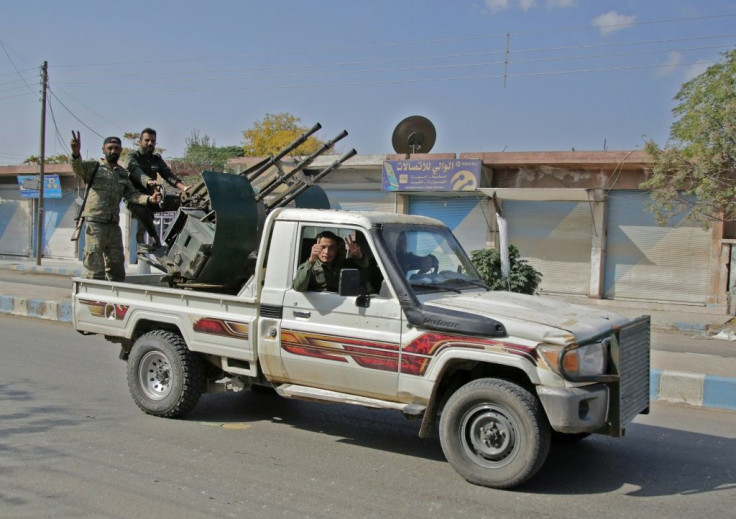What Is The 'Safe Zone' Turkey Wants In Syria?

Turkey agreed with the United States to suspend its deadly offensive in northern Syria, with President Recep Tayyip Erdogan promising to end the assault if Kurdish forces withdraw from a "safe zone" along the border.
From Ankara's point of view, this would allow Erdogan to kill two birds with one stone -- easing its refugee burden and pushing Kurdish militants away from Turkey's southern border.
Thursday's agreement on a 120-hour suspension came just over week after Ankara launched its cross-border operation against the Kurdish YPG militia on October 9.
Experts say Turkey still wants a "safe zone" on the same terms proposed before, while others argue it is difficult for Ankara to physically establish the area.
What is the 'safe zone'?
Before launching the operation, the Turkish government said it wanted a zone that would be 30 kilometres deep and run over 400 kilometres (300 miles) along northern Syria.
Erdogan has previously said this zone would then allow two to three million Syrian refugees to return to their country.
The issue has become a priority for the Turkish leader, who has faced a growing popular backlash over the presence of 3.6 million Syrian refugees in the country -- the highest number in the world.
The new zone would also be a buffer area against the Syrian Kurdish People's Protection Units (YPG), a Western-allied fighting force which has played a key role in the battle against the Islamic State group and other jihadists.
Ankara sees the YPG as a dangerous offshoot of what it considers Kurdish "terrorists" in Turkey, the Kurdistan Workers' Party (PKK) behind a decades-long insurgency against the state.
The "safe zone" was first publicly mooted earlier this year by President Donald Trump in a subsequently failed bid to stop Erdogan launching his operation.
US Vice President Mike Pence said after talks with Erdogan on Thursday that the YPG would withdraw "outside the 20-mile mark" but did not give further details.
What has changed?
James Jeffrey, the US special representative on Syria, said the status on the ground had now changed since Turkish forces entered Syria with their Syrian proxies.
"What we have now is a different situation where the Turks have pushed down to that 30 kilometre level in a central part of the northeast and they're still fighting in there," he said on board Secretary of State Mike Pompeo's plane on Thursday.
"The YPG elements in these areas that the Turks control will withdraw south of that area. That's basically the 30-kilometre area which is also the roads M4, M10," he said.
Turkish media have reported that Ankara aims to take control of a swathe of territory 120 kilometres (75 miles) long and 30 kilometres deep into Syria, up to the towns of Tal Abyad and Ras al-Ain.
Tal Abyad was captured last week by Turkey and its proxy forces but clashes continue in Ras al-Ain.
Turkey still wanted any final "safe zone" to be 444 kilometres long, Erdogan told reporters on Friday.
Hasan Unal, foreign policy analyst at Istanbul's Maltepe University, said the zone first proposed by Turkey remained Ankara's goal which includes the northern Syrian city of Manbij, the town of Kobane and the area up to the Iraq border to the east.
But this might prove difficult since Syrian regime forces have entered Manbij and Kobane after a deal with the Kurds, who sought protection from the Turkish assault.
Unal said it was likely the United States would "keep coming with different interpretations of the compromise", pointing to previous US-Turkey agreements in northern Syria.
In August, American and Turkish officials agreed to set up a buffer zone on the Turkey-Syria border but Ankara was unhappy with the lack of concrete developments.
However, Unal said future developments in Syria involving Turkey depended on the outcome of the meeting between Erdogan and Russian President Vladimir Putin next Tuesday.
"What might happen with regards to Turkish action in northeast Syria, Turkish-Syrian relations, with regard to Turkish attitudes towards a new Syria seems to largely depend on that (meeting)," he said, adding that no "miracle" should be expected.
Can it really be set up?
According to Anthony Skinner, director at the risk assessment firm Verisk Maplecroft, too many unanswered questions remained over Ankara's ability to control the zone.
"Turkey has not been able to secure the funding it wants to be able to develop the infrastructure for this resettlement programme to succeed," he told AFP.
And, Skinner added, "it is unclear how a sufficiently robust non-Turkish force could be sustained on the ground in the longer term to keep the peace at a local level".
Syria expert Fabrice Balanche said last month that it would not be possible to send three million people to the proposed region because the liveable area was "limited".
burs-raz/txw/bp
© Copyright AFP 2024. All rights reserved.




















